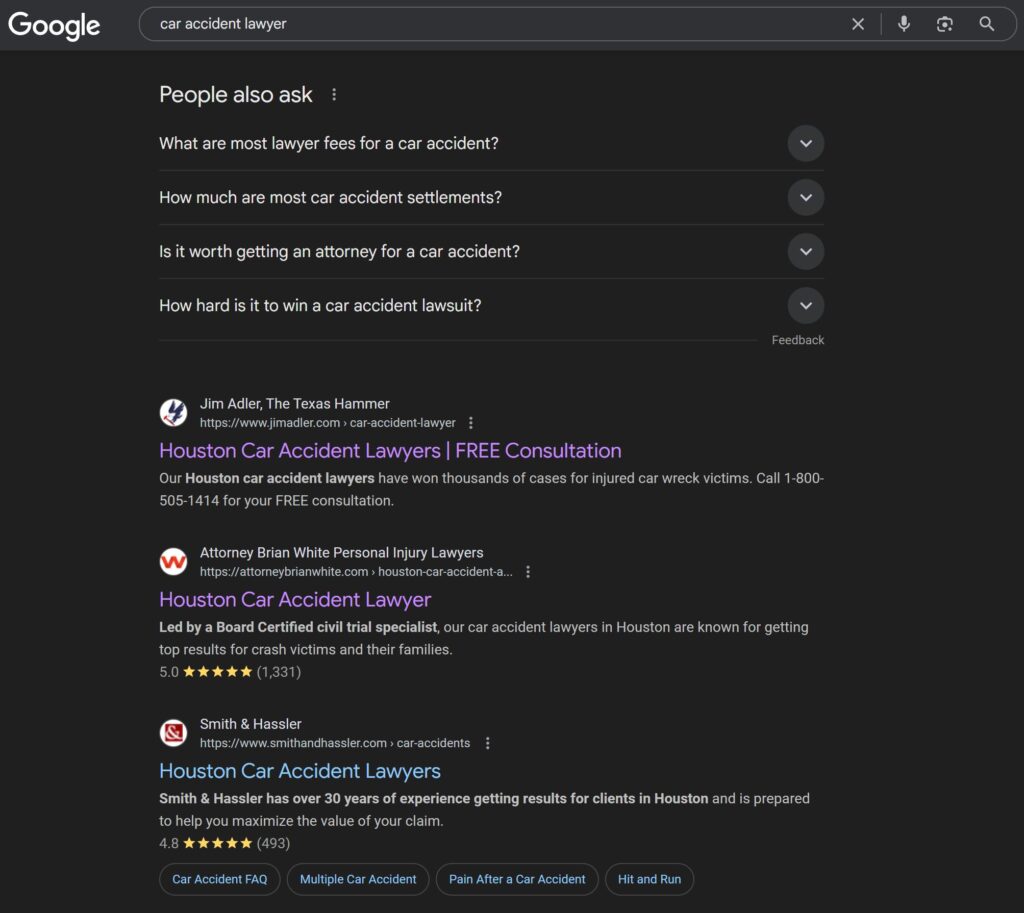Backlinks are still one of the most misunderstood (and often misused) SEO tactics in the legal world.
Agencies love to promise “thousands of high-DA links” while stuffing your site into shady blog networks or spammy directories. Meanwhile, law firms trying to rank in tough markets like Houston, LA, Atlanta, or Miami wonder why nothing’s moving.
Here’s the truth: Backlinks still matter in 2025. But only the right ones.
And in legal SEO, Google plays by a much stricter set of rules.
Key Takeaways
2. YMYL content (like law) faces stricter scrutiny. Machine learning systems actively dampen or ignore junk, spammy, or over-optimized backlinks.
3. Relevance, trust, and entity connections beat raw quantity. Local links, earned media, and association with credible sources matter most.
4. Forget “DA” and obsessing over “dofollow” links. Google cares more about real authority, editorial placement, and natural anchor usage.
5. Junk links won’t help and might hurt. Avoid PBNs, Fiverr gigs, or link farms entirely. Google can detect and discount them instantly.
6. Shift your mindset from “link building” to “entity building.” Modern SEO rewards firms that are cited, trusted, and known, not just linked.
Do Backlinks Still Matter?
Yes, backlinks still matter but probably not like you think.
Google still uses backlinks to understand trust, authority, and relevance. A good backlink says, “This site is worth paying attention to.”
But here’s the caveat.
In YMYL niches (law, finance, health), not all links are treated equally, and some are barely counted at all.
Why?
Google knows the high value of these search results often leads to:
- Massive link spam (PBNs, PR drops, AI-generated content farms)
- Over-optimized anchor text attacks
- Agencies buying exact match links like it’s 2012
So, they aggressively discount links in these verticals based on:
- Source trustworthiness
- Anchor variance (overuse of specific keywords in the backlink)
- Placement context (footer/sidebar = weaker than editorial)
- Vertical-specific thresholds (YMYL has higher standards)
This means a law firm’s website will be subject to stricter trust signals. Not just for its content, but also for the backlinks pointing to it.
Additionally, back in 2020, Google’s John Mueller publicly said:
“Just because there’s a link to your site somewhere doesn’t mean that we will count it. We have a lot of systems that try to understand which links to count.”
— Google Webmaster Central Office Hours
This directly supports the idea that Google doesn’t treat all links equally, especially if those links appear manipulative or unnatural.
In simpler terms, this means:
- Not every backlink helps.
- Some links do absolutely nothing.
- A few may even hurt you.
Google also uses AI models to suppress or negate links it sees as:
- Manipulative
- Irrelevant
- Over-optimized
- Low-trust (from junk sites or recycled domains)
Just remember, it’s not that backlinks don’t matter for YMYL sites, they’re just heavily filtered before passing on any value.
What Makes a Backlink Count in Legal SEO?
In 2025, the best backlinks are contextually aligned, locally relevant, and entity-reinforcing.
Here’s what that means:
1. Relevance
Is the linking site related to law, local events, legal education, or your practice area?
2. Authority
Does Google recognize the site as reputable in your field or region? A .gov or .edu link still beats 100 random blog mentions.
3. Placement
Is the link in the body of real editorial content—or buried in a footer/sidebar?
4. Anchor Context
Does the surrounding text make sense? Are you using varied anchor text, or just keyword-stuffing every time?
5. Trust Signals
Is the link part of a natural, earned connection—like media coverage or a professional listing—or clearly bought?
Types of Links That Still Work in 2025
Not all backlinks are created equal, but these categories continue to hold weight (if done correctly):
✅ Legal Directories
These directories are still useful (and often mentioned in AI search):
What to do: Set up clean profiles, link to practice area pages, and optimize for consistency.
✅ Local Sponsorships
Look for opportunities to sponsor:
- Youth sports teams
- Legal aid clinics
- Community events
What to do: Negotiate a backlink and logo placement. These links are local, earned, and contextually relevant.
✅ Scholarship Outreach
Create a scholarship tied to legal studies or community impact. Then pitch them to:
- .edu sites
- High school counselor pages
- Local news roundups
Why It’s Helpful: These can generate multiple authoritative links and real traffic.
✅ News & Media Mentions
Write about:
- Local legal trends
- Case law updates
- Public safety tips
Then pitch it to local reporters or bar blogs to include on their sites.
Did you know? Websites that mention your brand but don’t place a backlink to your site still help because Google still “sees” it.
✅ Legal Associations & Alumni Directories
Most bar associations and alumni groups have:
- Membership directories
- Event listings
- Speaker bios with link options
Links That You Should Avoid Like the Plague
Some backlinks don’t just fail, they can actively work against you.
You should avoid:
- Fiverr gigs with “1,000 backlinks for $20”
- Private Blog Networks (PBNs)
- Guest post farms that accept anything
- Foreign or non-niche sites with zero editorial oversight
Use Ahrefs, Semrush, or Google Search Console to monitor:
- Toxic referring domains
- Over-optimized anchor distribution
- Sudden surges in junk links
If it looks unnatural, Google probably sees it that way too.
The Big Shift: From Link Quantity to Entity Quality
In 2025, it’s not about who has the most backlinks. It’s about who Google trusts the most.
Take a look at the search results for “car accident lawyer” in Houston.
Based on publicly available SEO tools, you’ll see that Jim Adler usually ranks in the Top 3 organic positions (if not #1) despite having fewer backlinks to that specific page than every other firm on the list.

Why? Because Adler’s brand is:
- An established legal entity with strong trust signals
- Reinforced by years of media coverage, client reviews, and branded searches
- Supported by high-authority mentions across legal, local, and news domains (even if they aren’t all linking directly to that page)
This shift is especially important in YMYL niches like law. You can’t brute-force your way up with volume.
In other words, you need credibility everywhere your brand shows up.
A Mini Case Study: The Right Link = Big Impact
One of my law firm clients sponsored a local university’s criminal justice event. Their link was placed in the event recap blog.
That single link:
- Brought 12,000+ referral visitors over 8 months
- Was picked up by 4 local media outlets
- Helped them rank #1 for “[city name] criminal defense lawyer” within 60 days
That’s not magic. It’s alignment. Local, relevant, real.
Backlink Metrics That Actually Matter
Forget obsessing over “domain authority” or how many links you’ve built this month.
You should focus on:
- Referring Domains: Unique sources > spammy repetition
- Relevance: Local + topical = stronger signals
- Traffic: If users click it, Google values it
- Anchor Variation: Branded, URL, and partial-match anchors mixed naturally
TL;DR Backlinks That Work for Law Firms in 2025
Do this:
- Focus on relevance, not volume
- Get links from trusted legal, local, and educational sources
- Build brand mentions and entity trust
- Vary your anchor text
Avoid this:
- Buying junk links
- Relying on PBNs or Fiverr spam
- Over-optimizing anchors
Backlinks are still powerful but only if they help Google trust your law firm.
Want help building backlinks that actually work?
Don’t waste time chasing dead links or shady networks. Let’s build a custom backlink acquisition strategy that’s safe, scalable, and effective.
👉 Book a call with me today and let’s talk.


